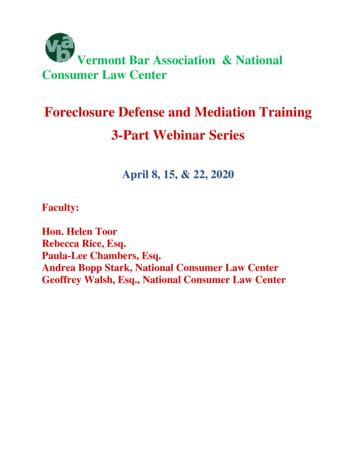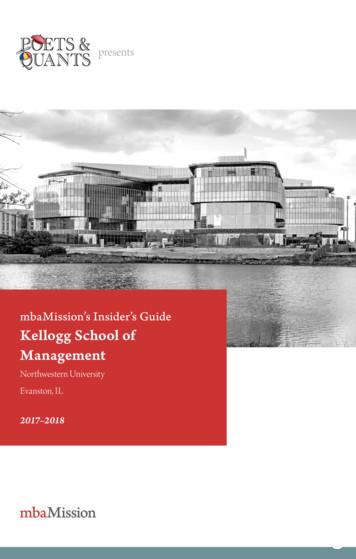INSIDER SECRETS FROM A FORECLOSURE TRUSTEE
INSIDER SECRETS FROM A FORECLOSURETRUSTEE INVESTING IN JUNIOR LIENSTHE DUE DILIGENCE CHECKLISTWHAT WE DO AND WHY WE DO IT
RULES I am not an attorney and I do not provide legal advice You are responsible for your level of knowledge and education Take Notes! This presentation is an outline There will be a Q & A period at the end of this presentation so saveyour questions!I AM AVAILABLE TO ANSWER QUESTIONS VIA EMAIL ANDCONTACT INFORMATION WILL BEPROVIDED AT THE END OF THIS PRESENTATION
WHAT WE WILL DISCUSSI have approximately 60 Minutes How to Succeed at Note investing The Purchase and Due Diligence The Collateral Foreclosure and ‘Pre-Foreclosure’ Exit Strategies What We do on our personal notes The Workout Additional Resources Question and Answers
THREE WAYS TO SUCCEED AND HOW TO DO IT Knowing the right people Sellers Vendors Trustee/Attorney CompetitionBe in the right place at the right time Be ready! Do as you say and say as you do Knowing more than the Next Person The more you know the better you will do You get what you pay for Ask questions but you will learn the most by becoming involved
EVALUATING A NOTE AND WHAT YOU AREGETTING INTO Take off your Real Estate hat Real Estate vs. NotesCost No Bad Notes only bad prices Cost of CollectionsTime Most of the work takes place before a note is purchased Collection timelines Risks of waiting
HOW MUCH DOES IT COST? Ask yourself these questions What type of note do I really want? How many notes could I handle if they were free Yields and returns vs expectationsCost of the note depends on the seller and the type of note Secured vs Unsecured Commercial vs Residential 1st position vs 2nd position Performing vs Non-Performing Foreclosure and Bankruptcy State How much information you are provided!
RESEARCH, PLAN & BUDGETDON’T BE AFRAID TO OUTSOURCE Don’t plan on eating the elephant with one bite Don’t blow your budget on the first transaction Research who you want to work with Assemble your team Trustee/Attorney Title (company or abstractor) Skip Tracing Door Knockers Loan Servicer Insurance and Real Estate Agents Product Sources Etc.
TIMEACTIVE VS. PASSIVE INVESTING Outsourcing Purchase Research Servicing Collections Foreclosure Legal
THE CHECKLISTEVALUATING THE PROPERTY Condition of Title and Collateral Secured vs Unsecured Lien position Adverse liens Taxes Assistance or other Jr. Liens ForeclosureEquity True Equity Positive Equity Negative Equity Emotional Equity
THE CHECKLISTEVALUATING THE HOMEOWNER Emotional Equity Condition Location CommunityBankruptcy Have they filed? Repeat Filings Intent Active, Dismissed and Discharged Planned Default
THE COLLATERALAND WHAT YOU ACTUALLY HAVE Deed of Trust/Mortgage Promissory Note Fixed/Amortized vs. HELOC Draw period vs. Repayment Period WSJ Prime vs. Treasury Yield and the Margin Endorsed Note/Allonge Loan Application Title Policy and/or HUD-1 Correspondence/Demands Payment History Credit Report
FORECLOSUREFRIEND OR FOE fore·clo·surefôrˈklōZHər/noun: foreclosure;plural noun: foreclosuresthe process of taking possession of a mortgagedproperty as a result of the mortgagor's failure tokeep up mortgage payments
THE TOOLS OF FORECLOSUREFRIEND OR FOEFRIENDFOE Gets the Homeowner’s Attention Costs Money Forces a limited timeframe Constructive knowledge and public recordState and Federal complianceissuesProperty sold at public sale Litigation Most people give up Easier, if well preparedSome fight too long fornothing
DIFFERENT KINDS OF FORECLOSURE(DIFFERS BY STATE AND SITUATION)NON-JUDICIAL FORECLOSUREJUDICIAL FORECLOSURE Deed of Trust/Note Mortgage Generally does not require courtaction Always requires court action Generally right to redeem Often used to clean up messes Recourse Generally NO right to redeem “As is” Generally NO recourse
COMPLIANCEBe familiar with: Your Collateral DocumentsThe foreclosure laws in the state where the Property is locatedState specific laws and requirements: Homeowner’s Bill of Rights Mediation Etc. CFPB FDCPA RESPA TILA
WHAT WE DO ON OUR PERSONAL NOTES Know Before you Go Title Payoff Quote From Sr. LienThe Wake-up 30 Day Demand Letter Statutory required notices with state specific languageForeclosure Calling the Homeowner(s) Door Knocker Additional Notices
EXIT STRATEGIES Reinstatement Payoff and Short Payoff Forbearance or Repayment Plan State and Local assistance programs Modification Deed in Lieu of Foreclosure Trustee Sale Assumption of Loan Sell your Note Deficiency Judgment Redemption Rights
THE WORKOUTYou are only limited by your imagination and the law Permanent – Semi-permanent – Temporary ‘New Principal Balance’ and Maturity Date Deferred Principal Balance Forgivable Principal Balance (Deferred Principal Reduction Amount) Step Up Interest Rates (Variable) Disclaimers – more is more What they have to do What will happen if they default What is a default Release of Claims Miscellaneous Provisions
RESOURCESNetrOnline – Public Recordswww.publicrecords.netronline.comConsumer Financial Protection Bureauwww.consumerfinance.govMortgage Banker’s Associationwww.mbaa.orgNationwide Mortgage Licensing lRegswww.allregs.comUnited Trustees Associationwww.unitedtrustees.comCalifornia Mortgage Broker’s Associationwww.CMBA.comUSFNwww.USFN.org(United States Foreclosure Network)Just to name a few
Rande Johnsen17100 Gillette Ave.Irvine, CA 92614rjohnsen@trusteecorps.comTel: 949-252-8300 x 190Matthew Kelley17100 Gillette Ave.Irvine, CA 92614mkelley@trusteecorps.comTel: 949-252-8300 x 424ANY QUESTIONS? PLEASE EMAIL USAND WE WILL GET BACK TO YOU!
FRIEND OR FOE fore·clo·sure fôrˈklōZHər/ noun: foreclosure; plural noun: foreclosures the process of t
4931—70. Note that the foreclosure statute received a significant overhaul in 2012. Vermont has three methods of foreclosure: Strict foreclosure under 12 V.S.A. § 4941; Judicial sale foreclosure under 12 V.S.A. §§ 4945-4954; and Nonjudicial foreclosure under 12 V.S.A. §§ 4961-70.
foreclosure process, foreclosure starts, has followed a similar pattern, with foreclosure starts exceeding the national level in every quarter since the third quarter of 1998. Introducing Regression To investigate the high levels of foreclosure in Indiana, the determinants of foreclosure rates are examined across the 50 states and Washington,
at the Foreclosure Sale. 18. High Bidder: The bidder at Foreclosure Sale that submits the highest responsive bid amount to the Foreclosure Commissioner. 19. Invitation: This Invitation to Bid including all the accompanying exhibits, which sets forth he terms and conditions of the sale of the Property at the Foreclosure Sale and includes
Dyer Alan Insider Wissen plus - Sterne ab 9 Graf Mike Insider Wissen plus - Stürme ab 9 Wade Rosalyn Insider Wissen plus - Naturgewalt Eis ab 9 Wilkinson Philip Insider Wissen plus - Das antike Rom ab 9 Murphy Glenn Insider Wissen plus - Verborgene Schätze ab 9 Hartmann Markus Lesezug.
mbaMission Insider’s Guide to the MIT Sloan School of Management mbaMission Insider’s Guide to New York University’s Leonard N. Stern School of Business mbaMission Insider’s Guide to the Stanford Graduate School of Business mbaMission Insider’s Guide to the Stephen M. Ross School of Business at the University of Michigan
Counter-Insider Threat Program Director's vision to integrate the social and behavioral sciences into the mission space. As part of a partnership with the PERSEREC Threat Lab, CDSE provides links to their insider threat resources in the Insider Threat toolkit. This promotes the applied use of research outcomes to the insider threat community.
Most debated aspects of insider trading included whether insider trading is rational and whether it should be regulated. The pros can cons of insider trading is also a topic that has been actively discussed in literature on law, economics and finance (Chauhan, Chaturvedula, and Iyer, 7). The existence of insider trading laws and their
The Cost of Insider Threats ObserveIT 2018 Cost of Insider Threats: 159 Global Organizations surveyed Insider Threats caused by: Negligence (64%); 3.81M USD Criminal insider (23%); 2.99M USD Credential Theft (13%): 1.96M USD Average of 73 days to contain an incident 16% contained in 30 days























